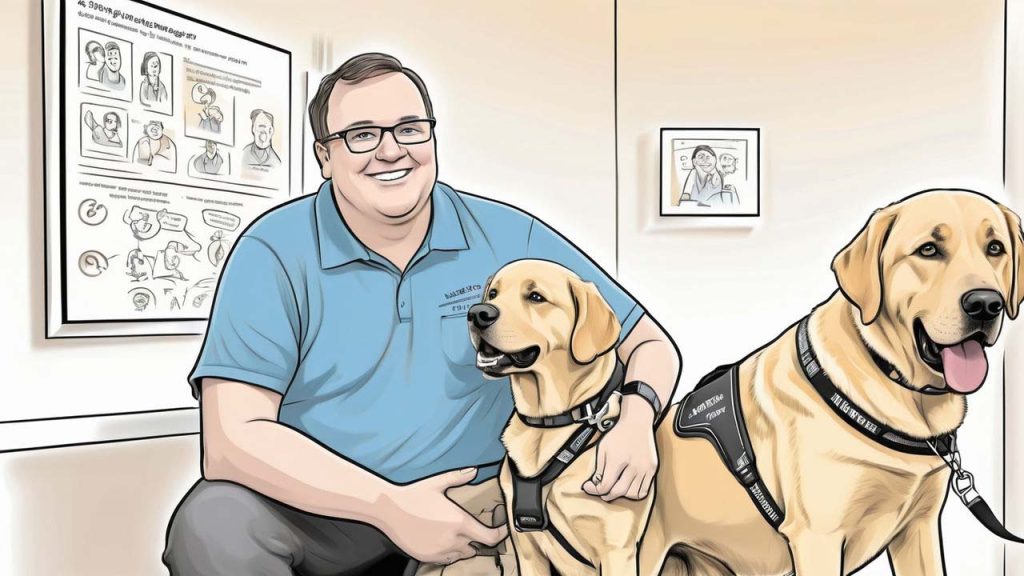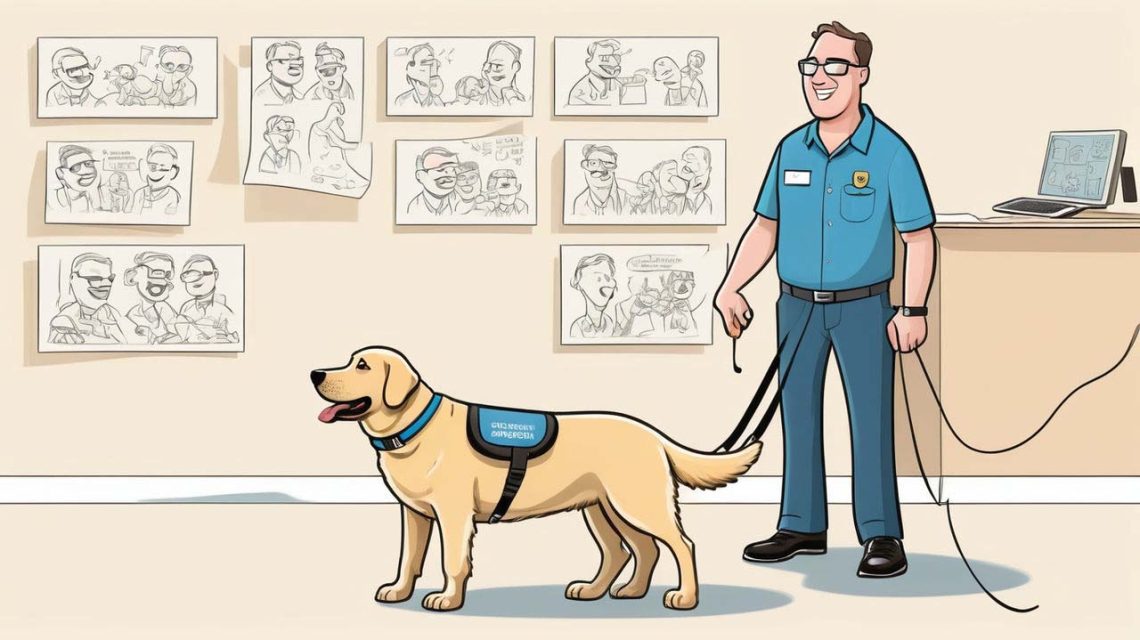Becoming a seeing eye dog instructor is a deeply rewarding career that combines training, compassion, and dedication. Instructors work with specially chosen dogs to develop their skills, preparing them to assist visually impaired individuals in navigating their surroundings safely. This role goes beyond traditional dog training; it involves building reliable, life-changing partnerships between dogs and their handlers, creating a pathway toward independence and confidence.
This article explores the journey of a seeing eye dog instructor, detailing the skills, training, and incredible impact they have on the lives of both dogs and handlers.
The Role of a Seeing Eye Dog Instructor
Seeing eye dog instructors are professionals responsible for training dogs to serve as guides for visually impaired individuals. Their work helps create partnerships that offer freedom, safety, and companionship.
1. Teaching Advanced Guiding Skills
Seeing eye dog instructors train dogs to safely guide their handlers through various environments, teaching them to avoid obstacles, navigate crosswalks, and handle busy settings.
2. Fostering Handler-Dog Partnerships
Instructors match each dog with a suitable handler and guide both through an intensive bonding process, ensuring compatibility and understanding between the pair.
3. Providing Emotional Support and Confidence
In addition to training, instructors offer emotional support, helping handlers build trust in their new seeing eye dog. This trust is crucial for navigating their world independently.

The Journey to Becoming a Seeing Eye Dog Instructor
The path to becoming a seeing eye dog instructor involves specialized training, hands-on experience, and a deep understanding of both dogs and the needs of visually impaired handlers. Here’s a step-by-step guide:
1. Gain Experience in Dog Training
Most seeing eye dog instructors start with a strong background in dog training, focusing on obedience, behavior, and socialization.
- Hands-On Training: Work with different breeds and temperaments to build a foundation in dog behavior. Many aspiring instructors begin by volunteering with puppy-raising programs.
- Professional Training Programs: Taking courses in animal behavior, obedience training, or similar fields provides a solid foundation for future specialized training.
2. Complete a Specialized Program in Seeing Eye Dog Instruction
Organizations like The Seeing Eye or Guide Dogs for the Blind offer specialized instructor programs. These programs provide in-depth training in guiding skills, instructor techniques, and handler support.
- Intensive Training Phases: The program includes multiple training phases, covering topics from advanced guide work to matching dogs with handlers and supporting handler-dog communication.
- Apprenticeships: Most programs include a hands-on apprenticeship, where trainees work alongside experienced instructors to gain direct experience.
3. Develop Skills in Human-Dog Communication
Seeing eye dog instructors work closely with both dogs and handlers, so effective communication is essential. This skill ensures they can translate dog behavior into actionable guidance for handlers.
- Training with Human Partners: Instructors learn to communicate commands and read dogs’ cues while managing the handler’s needs and concerns.
- Positive Reinforcement Techniques: Understanding and using positive reinforcement help instructors build trust with dogs and handlers, which is critical in seeing eye dog work.
4. Certification and Ongoing Education
While certification varies by region and organization, many seeing eye dog instructors pursue ongoing education to stay updated on best practices and techniques.
- Certification Options: Some organizations offer certification to validate skills and expertise in guide dog training.
- Workshops and Seminars: Regular workshops on animal behavior, training techniques, and visual impairment needs help instructors stay informed and effective.
Essential Skills for Seeing Eye Dog Instructors
To excel as a seeing eye dog instructor, one must possess a unique set of skills that support both training and interpersonal interaction.
1. Patience and Adaptability
Training seeing eye dogs and working with handlers requires patience. Every dog and handler pair learns at a different pace, so adaptability is key.
- Tailoring Techniques: Each dog-handler team is unique, requiring custom approaches for training and bonding.
- Building Trust Gradually: Instructors need the patience to build trust, especially as handlers learn to depend on their dog for safety.
2. Knowledge of Canine Behavior
A thorough understanding of canine behavior helps instructors effectively teach dogs and handle any behavioral challenges that arise during training.
- Reading Body Language: Recognizing and responding to dog body language is crucial to ensure the dog’s comfort and readiness to work.
- Behavior Modification Skills: Instructors address behaviors that may hinder a dog’s guiding abilities, ensuring each dog reaches its full potential.
3. Strong Interpersonal Skills
Seeing eye dog instructors work closely with handlers, often providing emotional support during the transition to life with a guide dog.
- Effective Communication: Clear communication with handlers is essential, as instructors teach them how to interpret their dog’s cues.
- Empathy and Support: Many handlers experience a range of emotions during training. Instructors provide guidance and encouragement to help them feel confident and empowered.
Stages of Seeing Eye Dog Training
Seeing eye dog training is divided into structured stages, each designed to build on the last. This ensures the dog’s readiness to guide and the handler’s confidence in their dog.
1. Basic Obedience and Socialization
Training begins with basic commands and socialization, teaching dogs foundational skills like “sit,” “stay,” and walking on a leash.
- Exposing to Diverse Environments: Dogs are introduced to different locations, from quiet parks to crowded city streets, to help them stay calm in all environments.
- Building a Solid Obedience Base: These commands form the basis for the advanced guiding tasks that follow.
2. Specialized Guide Training
Advanced training focuses on guiding skills specific to seeing eye dogs, such as obstacle avoidance, directional cues, and intelligent disobedience.
- Obstacle Avoidance: Dogs learn to recognize and navigate around hazards, such as curbs and objects in their path, ensuring their handler’s safety.
- Intelligent Disobedience: Instructors teach dogs to ignore commands that could lead to danger, like stopping when there’s oncoming traffic.
3. Matching Dogs with Handlers
One of the most rewarding parts of the job, instructors match each dog with a compatible handler, focusing on lifestyle, walking pace, and personality.
- Initial Bonding Sessions: Dogs and handlers work together, building a bond and establishing trust through guided activities.
- Training as a Team: Instructors oversee these sessions, helping handlers feel comfortable and confident with their new guide dog.
The Impact of Seeing Eye Dog Instructors on Handlers’ Lives
Seeing eye dog instructors change lives by facilitating partnerships that bring independence, confidence, and companionship to visually impaired individuals.
1. Empowering Handlers with Independence
Handlers gain the freedom to navigate their environments safely, relying on their guide dog for assistance with daily tasks and activities.
2. Building a Lifelong Bond
The instructor’s role in facilitating a strong bond between dog and handler has lasting effects, creating a sense of security, companionship, and mutual trust.
3. Providing Emotional Support During Transition
Adjusting to life with a guide dog can be emotional. Instructors offer guidance and reassurance, helping handlers feel more prepared and supported as they embark on their journey.
Challenges and Rewards of the Career
While being a seeing eye dog instructor is incredibly fulfilling, it comes with its own set of challenges and rewards.
Challenges
- Emotional Investment: Building relationships with dogs and handlers is rewarding but can be emotionally taxing.
- Rigorous Training Process: Training guide dogs to perfection requires perseverance and attention to detail, as any error could impact safety.
Rewards
- Transforming Lives: Seeing the bond between a dog and handler develop is one of the most rewarding experiences, knowing you’ve changed lives for the better.
- Developing Lifelong Skills: Instructors gain invaluable skills in training, empathy, and communication, benefiting both their career and personal growth.
FAQs About Becoming a Seeing Eye Dog Instructor
How long does it take to become a certified seeing eye dog instructor?
- Training typically takes 2-4 years, including specialized programs, apprenticeships, and hands-on experience.
What is the average salary of a seeing eye dog instructor?
- The average salary varies by region, but in the U.S., it typically ranges from $40,000 to $60,000, depending on experience and location.
Do you need a specific degree to become an instructor?
- While no specific degree is required, courses in animal behavior, psychology, or biology can be helpful. Most organizations provide extensive training programs.
How are instructors involved in the dog-handler matching process?
- Instructors evaluate both the dog’s and handler’s needs, personalities, and lifestyles to ensure the best match, fostering a successful partnership.
Is this a full-time role?
- Yes, most seeing eye dog instructors work full-time, as the role involves intensive training and often includes travel for handler sessions.


